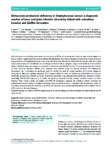Delta-toxin production deficiency in Staphylococcus aureus: a diagnostic marker of bone and joint infection chronicity linked with osteoblast invasion and biofilm formation
Biofilm formation, intra-osteoblastic persistence, small-colony variants (SCVs) and the dysregulation of agr, the major virulence regulon, are possibly involved in staphylococcal bone and joint infection (BJI) pathogenesis. We aimed to investigate the contributions of these mechanisms among a collection of 95 Staphylococcus aureus clinical isolates from 64 acute (67.4%) and 31 chronic (32.6%) first episodes of BJI. The included isolates were compared for internalization rate, cell damage and SCV intracellular emergence using an ex vivo model of human osteoblast infection. Biofilm formation was assessed in a microbead immobilization assay (BioFilm Ring test). Virulence gene profiles were assessed by DNA microarray. Seventeen different clonal complexes were identified among the screened collection. The staphylococcal internalization rate in osteoblasts was significantly higher for chronic than acute BJI isolates, regardless of the genetic background. Conversely, no differences regarding cytotoxicity, SCV emergence, biofilm formation and virulence gene distribution were observed. Additionally, agr dysfunction, detected by the lack of delta-toxin production using whole-cell matrix-assisted laser desorption ionization time-of-flight (MALDI-TOF) analysis (n = 15; 15.8%), was significantly associated with BJI chronicity, osteoblast invasion and biofilm formation. These findings provide new insights into MSSA BJI pathogenesis, suggesting the correlation between chronicity and staphylococcal osteoblast invasion. This adaptive mechanism, along with biofilm formation, is associated with agr dysfunction, which can be routinely assessed by delta-toxin detection using MALDI-TOF spectrum analysis, possibly providing clinicians with a diagnostic marker of BJI chronicity at the time of diagnosis.



